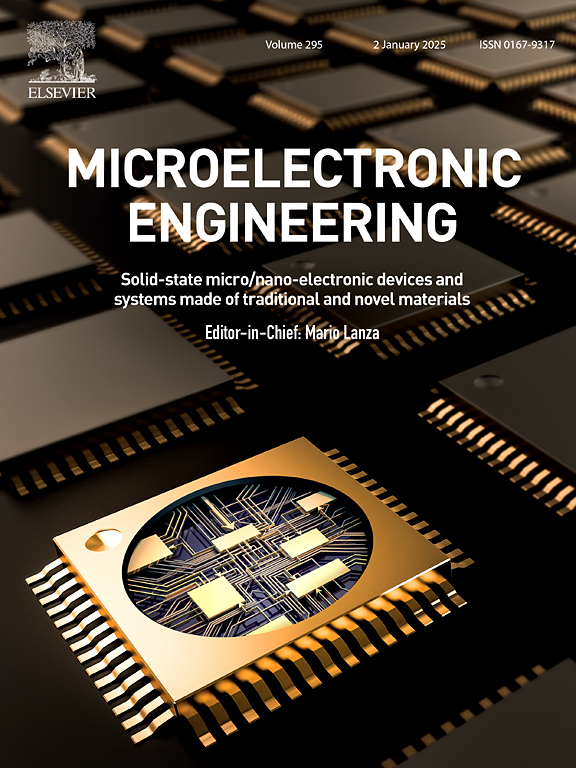β-Ga2O3 mosfet的最新进展:从材料生长到大功率电子器件架构
IF 3.1
4区 工程技术
Q2 ENGINEERING, ELECTRICAL & ELECTRONIC
引用次数: 0
摘要
β-氧化镓(β-Ga2O3)由于其超宽带隙(4.9 eV),特殊的击穿电场(8 MV/cm),以及与生产大面积单晶的具有成本效益的熔体生长方法的兼容性,已成为下一代电力电子的有前途的半导体材料。本文综述了β-Ga2O3金属氧化物半导体场效应晶体管(mosfet)的最新进展,从材料合成到器件实现。然后研究器件结构,检查耗尽模式和增强模式β-Ga2O3 mosfet。我们强调了关键的设计元素,包括场板,创新的栅极结构和通道工程技术,这些技术使器件的击穿电压超过2.3 kV,功率数字超过150 MW/cm2。此外,我们还解决了重大挑战,特别是β-Ga2O3相对较低的导热系数(10-20 W/m·K)和目前缺乏p型掺杂能力所引起的热管理问题,讨论了各种提出的解决方案,包括金刚石散热片,异质衬底集成和先进的封装方法。最后,我们研究了新兴的概念,如纳米膜晶体管、翅片结构和异质结场效应管,并对这一前景广阔的半导体技术的未来研究方向进行了总结。本文章由计算机程序翻译,如有差异,请以英文原文为准。
Recent advancement in β-Ga2O3 MOSFETs: From material growth to device architectures for high-power electronics
Beta‑gallium oxide (β-Ga2O3) has emerged as a promising semiconductor material for next-generation power electronics due to its ultra-wide bandgap (4.9 eV), exceptional breakdown electric field (8 MV/cm), and compatibility with cost-effective melt growth methods for producing large-area single crystals. This comprehensive review examines recent advances in β-Ga2O3 metal-oxide-semiconductor field-effect transistors (MOSFETs), spanning from material synthesis to device implementation. The review then investigates device architectures, examining both depletion-mode and enhancement-mode β-Ga2O3 MOSFETs. We highlight crucial design elements including field plates, innovative gate structures, and channel engineering techniques that have enabled devices with breakdown voltages exceeding 2.3 kV and power figures of merit surpassing 150 MW/cm2. Additionally, we address significant challenges, particularly thermal management issues stemming from β-Ga2O3's relatively low thermal conductivity (10–20 W/m·K) and the current absence of p-type doping capability, discussing various proposed solutions including diamond heat spreaders, heterogeneous substrate integration, and advanced packaging approaches. Finally, we examine emerging concepts such as nanomembrane transistors, fin structures, and heterojunction FETs, concluding with insights on future research directions for this promising semiconductor technology.
求助全文
通过发布文献求助,成功后即可免费获取论文全文。
去求助
来源期刊

Microelectronic Engineering
工程技术-工程:电子与电气
CiteScore
5.30
自引率
4.30%
发文量
131
审稿时长
29 days
期刊介绍:
Microelectronic Engineering is the premier nanoprocessing, and nanotechnology journal focusing on fabrication of electronic, photonic, bioelectronic, electromechanic and fluidic devices and systems, and their applications in the broad areas of electronics, photonics, energy, life sciences, and environment. It covers also the expanding interdisciplinary field of "more than Moore" and "beyond Moore" integrated nanoelectronics / photonics and micro-/nano-/bio-systems. Through its unique mixture of peer-reviewed articles, reviews, accelerated publications, short and Technical notes, and the latest research news on key developments, Microelectronic Engineering provides comprehensive coverage of this exciting, interdisciplinary and dynamic new field for researchers in academia and professionals in industry.
 求助内容:
求助内容: 应助结果提醒方式:
应助结果提醒方式:


